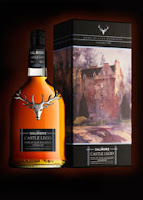 Dalmore is a distillery that is located in the northern Highland town of Alness and was founded in 1839 by Alexander Matheson. It is currently owned by the famous whisky name of Whyte & Mackay, which is now a subsidiary of the Indian owned company United Spirits. The company own the famous Whyte & Mackay blended brand, as well as the distilleries of Fettercairn, Jura and Tamnavulin. United Spirits took over in 2007 and have since re-branded the Dalmore whisky range and packaging. Dalmore has an annual production capacity of around four million litres and has long been renowned for their use of high quality sherry casks during maturation.
Dalmore is a distillery that is located in the northern Highland town of Alness and was founded in 1839 by Alexander Matheson. It is currently owned by the famous whisky name of Whyte & Mackay, which is now a subsidiary of the Indian owned company United Spirits. The company own the famous Whyte & Mackay blended brand, as well as the distilleries of Fettercairn, Jura and Tamnavulin. United Spirits took over in 2007 and have since re-branded the Dalmore whisky range and packaging. Dalmore has an annual production capacity of around four million litres and has long been renowned for their use of high quality sherry casks during maturation.Castle Leod is the home of the Chief of the MacKenzie clan and is located near the town of Strathpeffer. This lies to the north of Inverness in the northern Highlands and was famous in Victorian times for the healing properties of its natural spring waters. The castle is just 14 miles from Dalmore and the MacKenzie family once owned the distillery. The association can also be seen in the fact that both have the Royal stag's head as their symbol. The current castle was built in 1606 on the site of an ancient Pictish fort. It is built of local red sandstone and has walls as thick as eight feet thick (2.4 metres) in places.
This whisky has been bottled and released by Whyte & Mackay to celebrate the long association with the Mackenzie family and to help raise money for much needed renovation work at Castle Leod, which features on the packaging. The Dalmore Castle Leod is limited to just 5,000 bottles and should retail at around the £100 mark in specialist whisky retailers. The whisky was distilled in 1995 and has spent the majority of its time maturing in a combination of ex-bourbon and ex-sherry casks, before transferring for the last 18 months to red wine casks. These casks had previously held Cabernet Sauvignon wine and were sourced from a Premier Cru vineyard in the Bordeaux region of France.
Our tasting notes
The colour of Castle Leod is a rich, dark amber and the nose is rich and powerful with plenty of expressive, almost exaggerated aromas. There are initial notes of caramel, treacle and robust malted barley grains, which are joined by a strong orange citrus aroma (think of candied orange peel and marmalade). More subtle notes of honey and vanilla are detectable, before distinct fruity red wine aromas come through (imagine red fruit and woody, tannic spices). On the palate, this feels viscous, oily and rich with plenty of dark sugar/treacle/molasses notes to begin with. Then come tangy citrus flavours (think of orange peel or orange oil), lots of tannic drying wood spices (imagine cinnamon and nutmeg), some burnt cereals and dark dried fruits (especially raisins, figs and prunes). In the background are hints of dark chocolate and espresso coffee. The whisky grips to your palate, with the vibrant red wine tannins and dry woody spices lingering long in to the finish. The finish is complex and starts with initial sweetness then moving through burnt sugar/caramel to tangy orange and finally those tannic, dry spices.
What's the verdict?
Dalmore's Castle Leod is a good example of a wine cask finished whisky, although it may be too overpowering and rich for some. If you like this style of whisky with its exaggerated, almost heavy, aromas and flavours then you need to search this one out and give it a go. The whisky's limited numbers and Dalmore's high profile will mean that this sells quickly, so if don't waste time if you want a bottle.

No comments:
Post a Comment